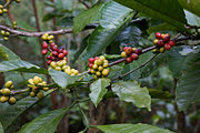Coffee Bean Varieties
There are two main species of coffee beans in the world, Coffee Arabica, and Coffee Robusta. More than three-quarters of the beans that are sold in the world today are Coffea Arabica, the majority of the remainding bulk are Coffea Robusta also known as Coffea Canephora.
Coffee Robusta:
These beans are of a lower grade than Arabica, and are typically grown at lower elevations. They are easier to grow and maintain, and they are also more disease resistant and produce a higher yield. Robusta beans have more of an astringent flavor and contain a higher amount of caffeine.
Coffee Arabica:
These are the higher quality beans and are referred to as gourmet coffee. They have half the amount of caffeine as Robusta and have more pleasing flavours and aromatic properties. Most Arabica bean varieties are name after their country or region in which they are found, or originated from.
Other bean species include: benghalensis, Bengal coffee; Coffea congensis, Congo coffee; Coffea liberica, Liberian coffee; Coffea stenophylla, Sierra Leonian coffee; Coffea excelsia, another Liberian coffee; Coffea bonnieri; Coffea gallienii; and Coffea mogeneti, however these beans are non-existent in the export market.
The Lifecycle of the Coffee Bean

Before the Coffee bean is ground down, peculated and poured into our coffee cup it goes through a series of processes spanning over a period of months.
Harvesting
The Coffee tree starts its life as a seed and after 4 to 8 weeks it develops into a seedling. At this stage the seedling needs be handled with care making sure the soil remains moist and does not attract too much sunlight. After about 9 to 18 months the coffee tree will grow to about 12 inches tall. It is a further 3 years before the tree bears fruit, (known as cherries), and a further 6 years before it is fully mature and producing fruit fully. At this stage the trees are ready for harvesting. This is done manually by the locals and usually all hands are on deck.
Picking
A good coffee picker can pick the equivalent of 50 to 60 pounds of coffee eans in a day. The average life in a day. span for a coffee tree is about 20 to 25 years, yielding around 2000 beans per year.
Sorting
Once the cherries have been picked they are ready for sorting. This can be done in different ways depending on the outcome of the required coffee taste. The first way is for ‘Aged coffee’ only, and involves keeping the green bean in a well ventilated warehouse for 1-7 years. This gives the beans a less acidic taste and a syrupy richness.
Processing
Dry Processing involves drying the cherries in the sun, then removing the pulp, parchment and dried skin. This can take up to two weeks and the beans must be continuously raked to prevent mildew.
Wet Processing this method involves putting the cherries in water; any ones that float are removed as defective. The cherries are then pressed by a machine which only allows the seed and some pulp to pass through the holes. The remaining pulp is removed leaving the beans which are then left to dry leaving about 10 - 12 percent moisture content.
Hulling
Mahines are used to remove the parchment layer from the wet processed coffee beans. The dry process involves removing the entire dried husk of the dried cherries
Polishing
A polishing machine is used to remove any silver skin that is left on after the hulling process
Cleaning, Sorting and Grading
Before the beans are exported tthey are sorted again by sizes and weight, and then they are checked again for colour flaws or other imperfections. Any beans with the slightest imperfection will be removed.
Exporting the Coffee
The beans are now referred to as Green beans and are ready for exporting. Their is approximately seven million tons of green coffee produced worldwide each year.
Tasting the Coffee
At every stage of coffee production the coffee is repeatedly tested for quality and taste. This process is referred to as cupping and takes place in a room specifically designed for this process. An experienced cupper is can taste hundreds of samples of coffee a day and still taste the subtle differences between them.
Roasting the Coffee
This is normally done in the importing country because freshly roasted beans must reach the consumer as quickly as possible. The process of roasting the coffee beans involves roasting them at 550 degrees Fahrenheit. The beans are kept moving throughout the entire process to stop them from burning. When they reach a temperature of about 400 degrees they begin to turn brown and the caffeol or oil that is locked inside the bean starts to emerge. This process is is what produces the flavour and aroma of the coffee. Once the beans are removed from the roaster they are immediately cooled with by air or water.
Now its time to enjoy your Perfect Brew!!